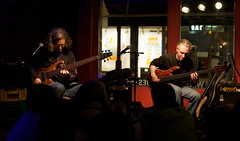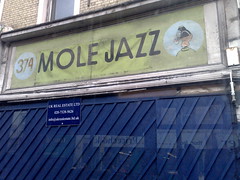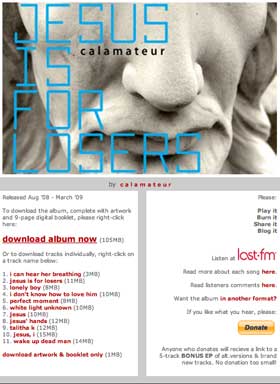[This started out as being my first post for MusicThinkTank.com, a site I’ve been invited to blog for, but ended up far too long to post there, so I’ll put it here, and post something else there… 🙂 ]
So Trent Reznor has gone one step further than he did with Ghosts, and is giving all of his new album away TOTALLY for free. No high dollar packages – at least for now – just free downloads, including putting massively hi-res versions on Bit Torrent, with a CD/Vinyl release to follow in July. (No mention yet of extra tracks on the physical release)…
Since Radiohead and Prince ‘gave albums away’ last year, we’ve all been talking endlessly about whether or not all music should be ‘free’, whether this is the new model that we should all adopt.
Two things are clear about Radiohead, Prince and Trent Reznor – (1) they’re all massively wealthy, and (2) all could guarantee massive press coverage for a move as ‘bold’ as giving a record away.
From those two points, I think it’s easy to see why modeling our marketing strategies against these artists is a non-starter. Unless you’re independently wealthy, or have the kind of day-job that affords you both the time and resources to tour heavily to symbiotically promote YOU via the free downloads and the tour, there’s not really a comparison financially.
And as anyone knows who’s ever paid for print advertising, column inches are incredibly valuable – the value of the coverage that Radiohead got for ‘giving their music away for free’ must’ve run into millions of pounds worldwide – a new Radiohead album is frontpage news in Q and Spin, but not in all the national newspapers around the world that covered it as a lead story, or on the television news programmes that led with it.
Copying the actions of celebrity millionaires is a bizarre kind of aspirational living – similar to that which drives Grazia-buying women to copy the fashions of the wives of sportsmen, and which causes millions of Americans vote for a political system that will leave them considerably financially worse off, ‘just in case they ever get rich’ – the myth of the American Dream, that anyone can get rich, keeps a lot of poor people voting for low taxation & lower government spending, because they’d hate to have their money taken off them when they get rich, despite the statistics showing that a minute number of people ever make the kind of quantum leaps in earnings that take even middle-income workers into the world of the super-rich. [I know there are a lot of other reasons why people might vote Republican or Libertarian, so please, no political comments on this one 😉 ]
Musicians are following suit, taking at face value the idea that Radiohead, NIN et al. gave away their music for ‘free’ and not looking at the massive value it carried as a press-generator for them in a way that just doesn’t work if you haven’t already had millions spent on you over years and years to get you to the place where your ‘free’ album is front page news.
Clearly, me ‘giving my music away’ and Radiohead ‘giving their music away’ are not comparable situations. Not at all.
For one thing, I’m a solo bass player. In a world where ‘pop’ music is driven by two main things – singing and drumming – I play instrumental music without a drummer, often without a fixed rhythm at all. Copying the broadcast-focussed actions of a bunch of zeitgeist-defining millionaire pop-stars is about as useful to me understanding my audience as putting videos of me reading Shakespeare on Youtube would be, just because a lot of people like Shakespeare.
Getting sidetracked by the aspiration to be a rock ‘n’ roll superstar is career suicide for an artist still needing to generate an audience to be monetized. I’ve said it before, and I’ll say it again, in the new music economy, any strategy that relies on Broadcast media but doesn’t have millions of dollars to invest to get that rolling is doomed to failure.
Yes, there’s the chance that something you ‘give away’ will ‘go viral’. There’s also a chance that you’ll win the lottery and be able to pay for all that lovely broadcast airtime you so crave. Neither happen anywhere near frequently enough to be statistically significant when planning how to build an audience and connect with them.
[this is the point that this post becomes ‘Social Media Thoughts Pt 5’]
No, we need to think differently, and the bit that we do have control over is the conversation. The back-and-forth with our audience, our friends and our peers about what we do and why we do it, framing out art in a dialogue about what it is, why it exists and the ways that people who like it have to support it.
That’s what social media presents us with. I can answer in-depth questions about what I do on the forum, I can invite comment about what I do, here on the blog via comments, I can answer one-line questions and field comments about gigs via twitter, creating a buzz about it amongst those people who get to hear about it.
Last Tuesday I did a gig at Darbucka, with Lobelia, and with the Lawson/Dodds/Wood trio (apparently we’re changing the order of the names in the band name – it’s getting very Spinal Tap! 🙂 ), and with special guests Lloyd Davis and Miriam Jones. Almost everyone there got in for free. The guestlist was HUGE. We made so little on the door as to be insignificant. However, the audience were, for the first time in AGES, largely people who’d never seen me play before, and as a result I sold more CDs at the gig that I have in ages at a Darbucka show. Miriam sold some CDs too, and the buzz afterwards on Twitter was huge – way more people talking about that gig via Twitter than any previous gig I’ve done. I got a lot of messages from people who were really sorry to have missed it, wanting to know when we’re playing again, and a lot of people downloading the free albums, and others buying Cds and downloads from the shop off the back of the gig. And there’s a LOT of talk about the forthcoming albums from both Lobelia and I and the trio…
So am I anti-free? Clearly not, the gig was essentially ‘free’, for most of the audience, but it was a different kind of free. It was free with context, free with value, in that everyone who was put on the guestlist was grateful, came with a sense of excitement and expectation, and went home talking about the gig. The music became a social object, something with value and cache, all of which is there to be monetized at a later date.
The bottom line is Don’t give it away for nothing, but the currency you trade in doesn’t have to be money
The gig, the music and my relationship with the people there was framed within the context of a series of social media-enabled conversations. I’m not suddenly going to fill Wembley by doing this, but the desire to fill Wembley is a destructive greedy pipe dream that ignores the beauty and value in where my music, career, and relationship with my audience is at NOW. I may one day fill Wembley, but I may also one day meet a benevolent billionaire on a plane who decides to sponsor my music to the tune of £200,000 a year, expecting nothing in return. Neither are a good plan to base a marketing strategy on.
So, forget about the mis-use of the word ‘free’ as applied to the ‘music in exchange for press coverage and gig promotion’ that already-successful multi-million-selling Rock stars do, and start focussing on the conversation you can have with your audience, using your music as a social object around which to build value, cache, excitement, events and value added product/scarcity-based revenue streams.
(A LOT of the stuff in this post is talked about in the Creative Coffee Club podcast That I recorded with Penny Jackson – If you’re interested in this stuff, you really ought to listen to it… )
 For many years, Â musicians have been looking for decent ways of hosting, embedding, distributing and selling music online. The shops that sell MP3s, on the back of iTunes success, are myriad. As are the sites that let you upload a few tunes and put them on your profile, ala Myspace, Reverbnation etc.
For many years, Â musicians have been looking for decent ways of hosting, embedding, distributing and selling music online. The shops that sell MP3s, on the back of iTunes success, are myriad. As are the sites that let you upload a few tunes and put them on your profile, ala Myspace, Reverbnation etc.


